At Kota Kinabalu in northern Borneo the locals careen their boats at the western end of Sutera Harbour on the last bit of sandy shore exposed on the spring, low tides. They bring their boats ashore at high tide and lay them across two large logs and when the boat settles on the logs they lash the gunwhales of the boat to the logs on both sides with doubled lashings. As the tide recedes they then tighten the ‘two’ ropes by twisting them until the boat is pinned to the logs (if it worked for the Romans!). After that they spend all night (at the moment) cleaning, painting and anti-fouling their boat and then untie the lashings as the boat starts to ‘float’ the logs on the rising tide; diurnal and very long tides here with one low and one high each day.
We are anchored just off the careening beach at Kota Kinabalu (KK) in company with Metana (Daryl), Mirage II (Dave) and Thyme (Simon, Amanda and Sloop). Thyme has been here for about a week while we all arrived here on July 28 after a bit over two weeks travelling east and north from the Santubong River. All three boats (Gadfly, Metana and Mirage) slipped out of the Santubong on Monday the 11th to spend a night in Muara Sabang, a little bay underneath Palau Lakei in the ‘Bako’ national park, about twenty miles to the east of Kuching; good chance here to clean ones bottom without risk of being bitten by crocodiles. Aboard for this leg were Flavia and friends from Sydney, Cinnamon and son Phoenix, both on board for a week long holiday. Next day was a sixty mile hop to the mouth of the Belewai river where we arrived just on dusk and watched the sun set as we dropped the anchor. From here we had the choice of either a sixty mile hop around the top of Pulau Beruit, or take the fifty mile option through the river. The river option sounded better so we spent the day looking for dolphins, avoiding shallow sand bars, considering the local timber industry and marvelling at the amount of palm oil they grow here. That evening we anchored in the channel between Pulau Beruit and Pulau Patok and after a few drinks went ashore at Kampong Bruit for a visit. Bruit is ones classic fishing Kampong with houses built pretty much over the water and joined by raised walk ways and bridges. The people here were very happy to see us, seems we may have been the first non-Malays to visit for a few decades; do not swim, big crocodiles!
The plan after getting around or under the headland of Tanjung Sirik was a day hop to a village called ‘Mukah’ followed by a longer run of around 150 miles into Miri where the ‘Passage to the East’ Rally people were congregating for a soiree and free dinner prior to heading for the bright lights of Kota Kinabalu. The day run went well until we tried to find a way into Mukah. We had been advised that the channel was dredged and marked and that large vessels routinely enter the somewhat small port, but the only thing marking the entrance is an ‘all round danger’ marker and a wrecked and half buried in the bottom barge (one of these big ones they haul sand around on for some obscure reason). Anyway we were eventually joined by a local fishing boat who offered to guide us in so in line with the local fishermen we followed our new friend while calling the depths between us as the bottom got closer to our boats. Shallow here on the non-marked entrance and in typical boat fashion just as the Gadfly was scraping off some barnacles the pulley wheel on the raw water pump decided enough is enough and gave the game away. The plan then became get the boat into the deeper water just ahead, anchor and resolve the problem; except that as the engine temperature soared the hose at the bottom of the fresh-water pump decided to let go and compound the developing dilemna; oh joy, all this on a falling tide and with enough water under the keel to just accommodate a sea-snake. Anyway Trevor was endeavouring to resolve the problem when our new fisherman friend came back out and offered a tow so thirty minutes later we were tied up at the floating pontoon in the middle of town with Metana and Mirage rafted outboard.
The locals here were fabulous and had moved three boats to get us alongside where we were to spend two nights, fifty metres from the local fish market and vegetable market, as well as service station for diesel and water. It seems the whole town came down to see the boats, because, as they told us, “no boats ever come in here”, no surprises there really. We even had some local journalists come down to interview us and ask us where we were from, “Really, Australia? Is very long way on small boat”!! When we tied up the locals pushed a fellow forward ‘Ali’ who is a mechanic and after a chat he raced down to start resolving pump problems and suggested next day we should cut a keyway in the pump pulley wheel to sort the problem. It turns out Ali is the brother of ‘Ahmed’ who is the owner and skipper of our fishing/pilot boat and tow vessel; bit of a family thing happening here with the fishing industry it seems. We gave Ahmed one of the cartons of Skol beer from Langkawi and also handed out beer to about twenty of the locals who had piled into the boat cockpit; amazing how warm they can drink beer here!! Next day Ali and friends cancelled their morning plans to take a mates son to Sibu to get a plane back to Newcastle in Australia (they had actually already left but turned around when Trevor called) and took the pump and Trevor to another friends place to have a keyway cut and permanently sort out the pump issue (should have happened when fitted by previous owner but you get that). Anyway, after fitting the pump in the boat they headed for Sibu after refusing payment and only accepted a present of a ‘Hong Kong Bar’ T-shirt from Penang!
So at dawn on the morning of the 17th and on the high tide we headed out for an overnighter to Miri, Trevor this time single handed as the girls and Phoenix had decided to bus to Miri to ensure catching a plane on the 18th headed back to Australia. This went swimmingly with light conditions and then a great morning sail reaching up to the Marina at Miri; the only drama being the two clocks Trevor bought in Mukah where the alarms seemed to operate randomly and the trick became to set them for different times and assume one will go off early enough to check the boat and traffic. The rally boats were still in town and having a ‘free’ dinner that night for their race event up to KK, so, ‘when in Rome’ and not being inclined to knock back a free dinner, off we went.
A highlight of Miri was our trip out to the Niah Caves about 100 km west of Miri so after hiring a car we promptly got lost with Scottish Ron (crew from Metana) getting most frustrated when acting as guide. Ron had lived in Miri 27 years previously when working for Shell and couldn’t really have known that that what he presumed to be the one main road between Miri and Bintulu is actually somewhat newer than 27 years old but just not marked on maps; interesting concept. Anyway the caves are something to see with the birds nest scaffolding attached to the ceiling (20 to 30 metres up) and climbing ropes (actually long lengths of wood joined by wooden pegs) also attached to the cave ceiling so that locals can climb to their scaffolding to get at the nests. The caves go on for over a kilometre with enough space in the main cave to park a 747 jet (says this in the reading material) and in the painted cave there are 2500 year old paintings on the walls of people, boats and animals. Apparently the painted cave was a funeral site and in the 1950’s still contained remains of funereal boat-coffins laying about. The caves were a focus of one of David Attenborough’s films twenty years ago showing the locals climbing around six stories up on bamboo scaffolds (hanging from the ceiling) collecting their bird nests; unbelievable really.
On the way to Niah, Scottish Ron commented that the biggest change in the area he could see is the extent to which the rain-forest has been cleared. Everywhere we looked on the way to the caves all we could see was Palm Oil plantations and on the way back as he said, “all of this was virgin rainforest”. We had previously seen all the way through South-East Asia huge areas of Palm Oil production and had read and heard much about the issue, but here in Borneo the scale is simply staggering and very much in ones face. Where we could see forest there is everywhere areas that have just been stripped and burnt in anticipation of planting Elaeis guineensis Jacq., better known as ‘African Palm Oil’, as apparently the cheapest means to produce vegetable oil for all manner of use including and unbelievably, biodiesel. So here we are chopping down some of the worlds most stunning rain-forests so that we can continue to drive cars with gay abandon with what seems to be no concern about loss of biodiversity, loss of habitat, land and topsoil degredation not to mention increased green-house gas emission. French Nathalie at the marina had worded us up on the Palm Oil paradigm but still something to see and frustrating that it couldn’t be undertaken in something more environmentally sustainable or even considered. The park at Niah (a world heritage site) is quite spectacular but is now an island in the middle of a massive mono-culture crop of palms. In other parts of Borneo we had seen areas where the rain-forest had been left along roadsides to obscure the palm oil stands, but on the unmarked road to Bintulu, they don’t even bother to do this.
We spent four nights in Miri and again in company and now with German ‘Janja’ on board for the leg to Labuan we slipped out early on the 22nd for the one hundred and ten mile run to the top of Bruneii Bay and Labuan. This involved an overnight stop off Tutong on the Bruneii coast where the Sultan’s brother has built a flash new harbour that could hold a small Naval task force. Nothing at all inside the two enormous breakwaters though, except of course for that very little but aesthetically pleasing island. Ron did speculate that the harbour may have been constructed to accommodate the two destroyers that the same brother had ordered and had built in the UK that are now and probably inevitably, in moth-balls as the Bruneii Navy doesn’t extend to enough personnel to man even one; ah well, the harbour looked nice.
Labuan is an oil town with a history of British coal mining and oil production. It also sits quite high in the pantheon of Australian military endeavours against the Japanese and Australia has named minor war vessels Labuan and Balikpapan in memory of landings in Borneo. The oil industry is still huge along this part of Borneo and we spent the best part of two days passing all manner of production and drilling platforms. In Port Victoria on Labuan there were any number of rig support ships at anchor although one assumes that like everywhere else in Asia these boats probably spend time towing barge loads of sand around to keep them occupied; towing, towing, towing. We hired a car for the day here and went out to see the sights, Aquarium, Museum, Coal Mining Museum, Buddhist Temple, Surrender Point and of course the War Memorial and Cemetery. The aquarium was a laugh, interesting but where you can’t afford to have fish, just have plastic ones! On more sombre locations, ‘Surrender Point’ on the west coast, is near where the amphibious forces (mainly Australian) came ashore and where the Japanese forces in Borneo finally surrendered at the end of WW2. The location then became the headquarters for the Australian 9th Division and where war crimes trials were carried out following the cessation of hostilities. Now there is a ‘Peace Park’ there, built by the Japanese in the 1980’s. The cemetery on the east coast contains almost 4000 people who died on active service in Borneo during the war with over half unidentified aside from country. The memorial is dedicated also to those whose graves are unknown and to the servicemen who died on the ‘Sandakan Death March’, when the Japanese marched over a thousand POW(s) 260 km from Sandakan on the east coast to Ranau, inland near Mt Kinabalu; only 6 survived the war (three died shortly thereafter) and they had escaped and were helped by locals.
From Labuan it is only 36 miles to Pulau Tiga, then another 30 miles to KK. We stopped for a night anchored in front of the resort at Tiga (most expensive beer in Christendom although we are in a Moslem country), then next morning we sallied forth for ‘Pulau Gaya’, the big island just to the north of KK. Here we once again came across the good ship Thyme, Simon, Amanda and Sloop with Americans Ben and Josh on board; although when we passed them in the first bay the only welcome we got was from Sloop as the rest were diving. First order of the day after the diving was beers and the obligatory bombing competition followed by a dive for Trevor after leaving on his sunglasses. That night was the standard fire and music on the beach with the guitar going ashore off Gadfly and sore heads next morning.
The Thyme people have since been busy looking after Amanda’s parents and their concerns about local food, while the intrepid three (Trevor, Dave and Daryl) decided a road trip was in order and hired a car to have a look at Mt Kinabalu and the ‘Poring Hot Springs’ and rain forest walk; we wanted to go up the Mountain but the mandatory guided walk costs $400; bit much for these yachties.
So here we are anchored out in Sutera harbour watching the locals boats come and go off their beach and listening to the roar of the little go-fast boats from the sea, pole-village at the other end of the harbour. These boats are about three to five metres long, one to two metres wide and have a large and very noisy inboard engine in them. The drivers steer them with a long tiller and clearly the faster, noisier and more brightly painted they are the better. There seems to be a lot of the pole-village people employed on the rather expansive development taking place just up the canal nearby and the preferred means of transport for the villagers is their own go-fast boat or go-fast taxi. On developments and building things, KK has the same scale of construction going nowhere (completed and not) that happens in the rest of Malaysia, but the need to build things goes on unabated. On the waterfront here there is a whopping great shopping and board-walk complex being completed that is completely at the wrong end of town and will probably look quite ordinary and empty in five years; shades of the ‘Festive Street Mall at JB’. Sadly the building of the waterfront board-walk seems to have reduced the careening beach to just the 50 metres or so up near the canal and this is squeezed between development sites. Fishermen have probably careened and worked on their boats along this end of the harbour for hundreds of years, one wonders when the last one will come up?
Careening a vessel or boat means to beach it at high tide in order, usually, to expose one side or another of the ship’s hull for maintenance below the water line when the tide goes out. Careening can be accomplished by either laying a boat or each side in successive tides or by holding a vessel upright to give access to both sides simultaneously.
The process could be assisted by securing a top halyard to a fixed object such as a tree or rock to pull the mast over as far as possible. Maintenance might include repairing damage caused by dry rot or cannon shot, tarring the exterior to reduce leakage, or removing biofouling organisms such as barnacles to increase the ship’s speed. A particularly well-protected area might be called “Careening Bay” to the locals. Pirates would often careen their ships because they had no access to drydocks.
A secluded bay would suffice for necessary repairs and/or hull cleaning, and such little “safe havens” could be found throughout the islands in the Caribbean and nearly around the world. One group of islands, Tres Marias, became popular when Francis Drake had sailed there in 1579 and quickly became a place for piracy.


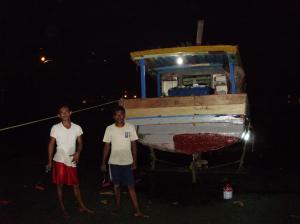






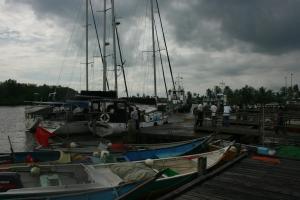





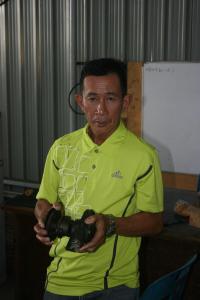
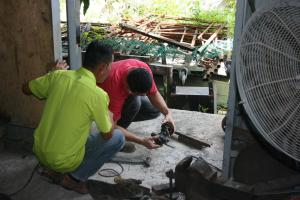





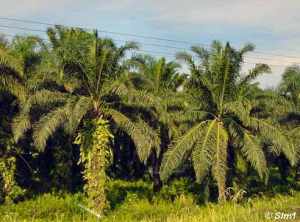













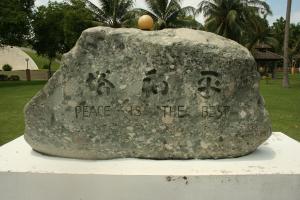
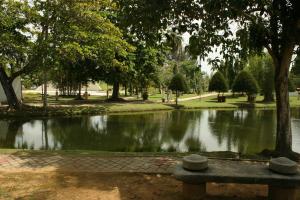





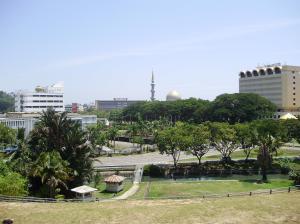



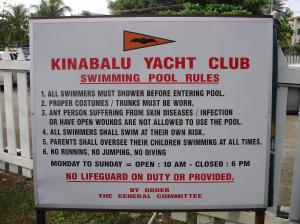



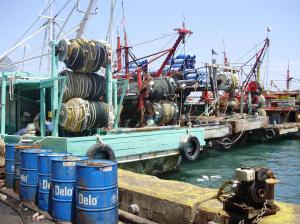




August 7, 2011 at 11:39 am |
Hi Trevor,
Avidly and very enviously following your travels… looks like a fantastic trip. Maria (Dublin)
August 7, 2011 at 12:42 pm |
hi Trev
Well finally following your blog cool – I was also quite surprised at the amount of palm oil plantations as we flew into KL after leaving Langkawi I actually made the comment to the couple next to me on the plane – is such a shame I try not to buy anything with palm oil but understand it is pretty much in a lot of what is produced.
Enjoy you are having an amazing trip
Shaz